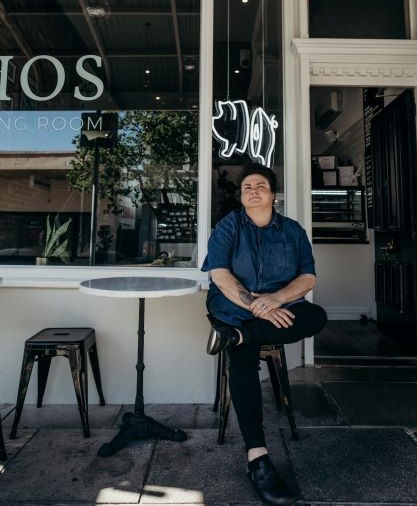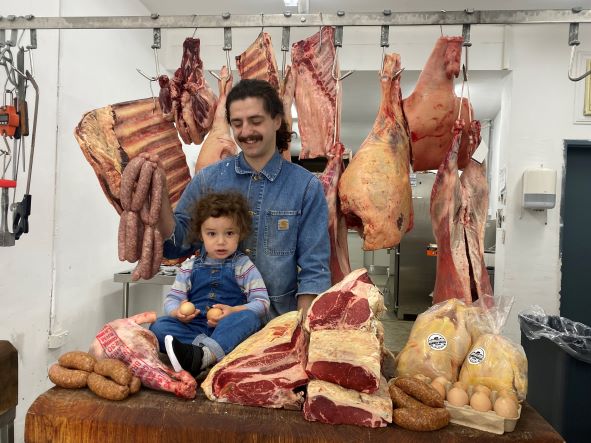Mortadella has fallen in the shadow of its cured-meat counterparts for too long. Its pale, white-specked appearance has largely resulted in customers steering clear of the meat, but if you ask a butcher or a chef, they will say it’s one of the finest. And the dining public is finally starting to see the light.
Hospitality speaks to Chef Melissa Palinkas and Butcher Marcus Papadopoulo on busting mortadella myths, the production process and its rising status in kitchens.
Melissa Palinkas is the head chef and owner of Young George restaurant and Ethos Deli in East Fremantle, Perth. Mortadella is generally perceived as a high-fat small good, when in actuality, it’s the opposite. “There’s no fat content in mortadella; traditionally it’s made from extremely lean pork,” says Palinkas. “When we make it, it’s pretty much 85 per cent lean pork and 15 per cent pork fat.”
As a chef that specialises in charcuterie, Palinkas believes serving quality mortadella is key to shifting public perceptions. Determined to explore the ins and outs of mortadella, Palinkas went to its birthplace in Italy, where she observed a completely different consumer attitude. “I went to Tuscany a couple of years ago to do a study of mortadella across the whole of Bologna,” she says. “You see the Italians and it’s a way of life for them. If everyone was serving it [here], people would probably catch on a little bit more.”

Marrickville Butcher Marcus Papadopoulo has a similar philosophy, and as a butcher, he knows producing premium mortadella starts with sourcing top-tier meat. He holds the meat industry accountable for the mass commercialisation and production of deli meats in general. “The mortadella market is saturated with poor-quality examples,” he says. “There is mortadella out there that is unbelievable. “If you go out and seek a good-quality example, you eat it and go, ‘This is a step above other things I’ve had before’.”
Papadopoulo says the emulsification process is what makes it hard for people to distinguish the ingredients that are in a mortadella. “Most people presume that not only is it bad, but it’s made with poor-quality ingredients,” he says. “It’s a classic joke that people think hot dogs have hooves and snouts in them. People speculate and they make jokes about it, and that’s why things like mortadella and Frankfurt sausages aren’t appreciated in the charcuterie world as much.”
Sourcing premium proteins is the first step. Palinkas finds pork locally, relying on her connections to pig farmers in Western Australia. “I’ve got several suppliers; I buy from small farms and a friend of mine has his own little farm where he grows pigs,” she says. “I’ve just started working with a new supplier from the southwest of Western Australia and I also use Linley Valley Pork as well.”
Whole Beast Butchery make mortadella from a range of proteins including pork, turkey and even kangaroo. Papadopoulo is passionate about dry ageing and avoids packaged meat. “One of the things we do at our shop that defines us is that we only use carcass meat,” he says. “We apply the method of dry ageing, hanging and maturing to everything we do.”

Once the protein is locked in, it’s a matter of working out the right combination of protein and fat. The ratio is crucial to achieving a balanced end result; too much fat and the mortadella can become greasy. Too little, and the mixture won’t emulsify properly.
Palinkas begins by breaking down the legs and shoulder meat of a pig for mincing. “We dice up the lean meat and take all the sinew out,” she says. “We have all our mixing accessories in the freezer because you want everything to be very cold when you mince. If it’s warm, it’ll just smear, and what you’re looking for is a nice grind.”
Because mortadella is served cold, flavour is important to keep in mind. After mincing, Palinkas adds spices including mace, coriander and white pepper along with milk powder, which acts as a tenderiser. The mixture is then paddled. “Paddling at a very high speed emulsifies the meat,” says the chef. “Basically, it breaks and smashes the proteins apart and becomes very smooth. It’s done in a machine that mixes at a high speed at the same time.”
At Whole Beast Butchery, Papadopoulo also likes to take his time with emulsification. He opts for a half and half ratio to make his mortadella. “You want generally around one-third to half,” he says. “We do half lean meat and half pure fat.”
As for seasoning, he prefers to switch up the offering at Whole Beast based on the style of mortadella. “It can be seasoned a bunch of different ways whether you want to take it into a sweeter pork angle, which is kind of like a classic French-inspired flavour, or you could take it into something with more heat,” he says. “But we try and make it in a very unique way to give it a good all-round flavour.” The mortadella is then steamed and rested.
The simplicity of mortadella allows for many iterations and styles, and appreciation is often realised when it’s served in a simple application. “At Young George, we just shave it onto a plate with pickles,” says Palinkas. “In summer and spring, we buy shishito or padrón peppers and we pickle them and treat them the same way as gunda.”
Papadopoulo says mortadella can be used in a range of dishes and believes it can be a great alternative to bacon. “It can be sliced very thin for charcuterie or it can be sliced thicker and fried in a pan or on a barbecue for a sandwich,” he says. “It could also be diced up and put in something like a potato salad. Where someone uses bacon, they could definitely [swap in] mortadella.”
The public perception of mortadella has certainly shifted with more restaurants putting it on the menu thanks to local creating quality options. Changing a customer’s mind can often come down to a quick education. “If you’ve got a front-of-house person that can talk [customers] through it, they can explain mortadella a bit better,” says Palinkas.
Any foodstuff made with the right ingredients will result in a tastier product. And for Papadopoulo, the notion could not be more relevant for mortadella. “It’s like any other meat or small goods product; you want to find out who’s making it and if that artisan is making small-batch products,” says the butcher. “If it’s created by an artisan, it’s a multi-stage process; it should have good-quality meat in it and the end result should be a reflection of the effort and the quality that’s been put in there.”
Sponsored Content

Discover Dairy Farmers’ range of shredded cheese
Sponsored by Bega

Beachfront Melbourne Club catering & restaurant opportunity
Sponsored by Future Food
Trending Now
Resources
Lorem ipsum dolor sit amet, consectetur adipiscing elit. Fusce ac ornare lectus. Sed bibendum lobortis...
Lorem ipsum dolor sit amet, consectetur adipiscing elit. Fusce ac ornare lectus. Sed bibendum lobortis...
Sign up for our newsletter
